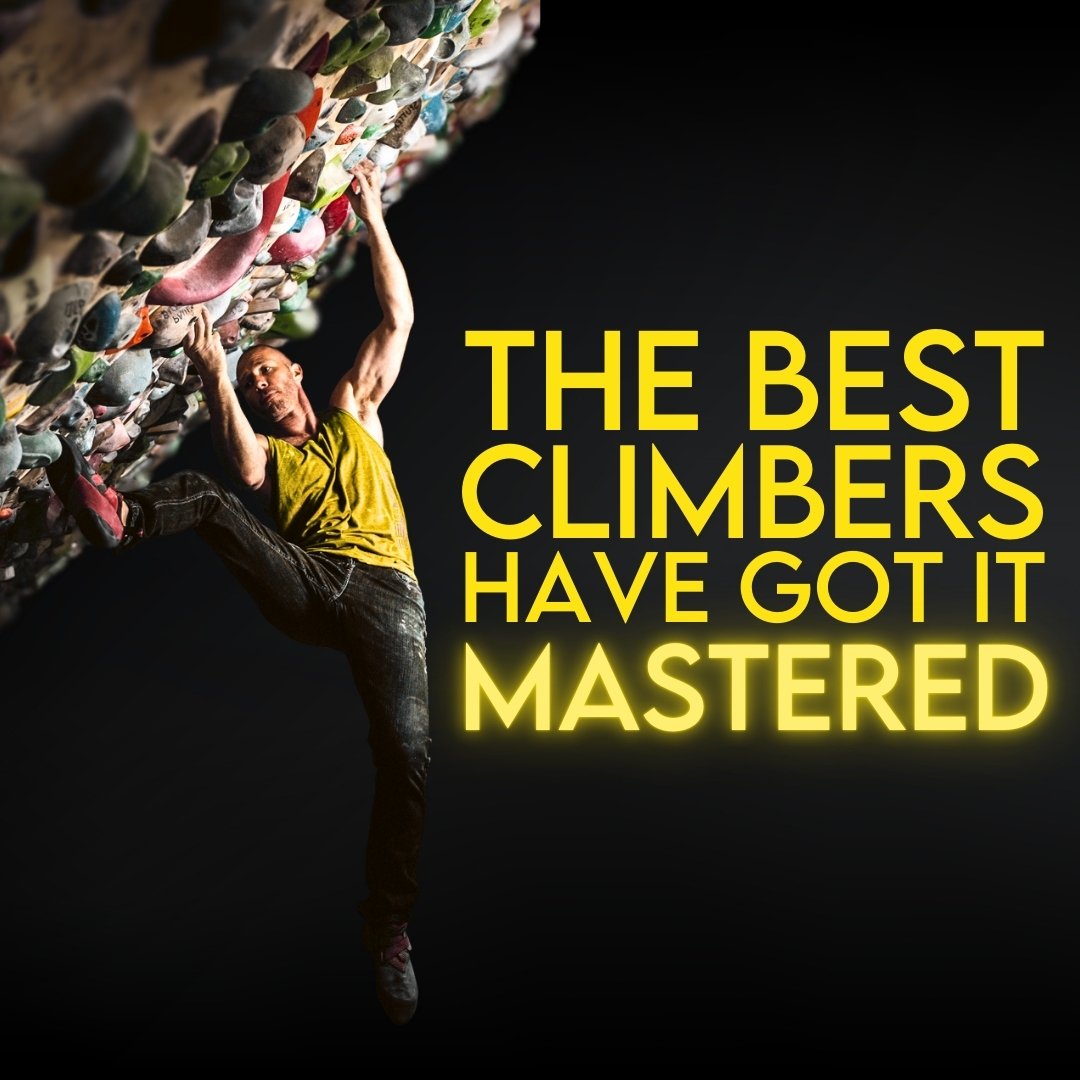3 Simple Bouldering Tips for Beginner to Intermediate Climbers
When you start climbing, if you’re the type of person who really loves the process of improving, then one of the first things you will do is look into how to train. I’m pretty certain that some variation of “how to train for bouldering” is one of the most Googled phrases for new boulderers. Probably right after, “What kind of fan do I buy for bouldering?”
I’m kidding.
Sort of.
But there’s a better question:
How can I improve my bouldering performance?
I’m going to share the top three performance mistakes that I see beginner boulderers making, why they are mistakes, and what you can do differently to make sure you’re improving faster.
When I say performance, I don’t necessarily mean outdoors. As a beginner, I personally think you should err toward doing more performance than training, simply because there is a LOT to learn about performance tactics and mindset that you just can’t gain through training alone. And once you know these things, your physical training will have a much higher rate of transfer. So if you aren’t climbing outside a lot, or indoor climbing is where your focus is, then you should absolutely be performing indoors.
I’m not saying don’t train. I’m just saying that:
As a relative beginner, performing should be 80% or more of your total climbing time, whether that is indoors or outdoors.
Performance, for me, is the pursuit of success, where training is the pursuit of failure. That’s a VERY simplified version of it, and eventually you’ll realize that there is a very thin and very blurry line between the two, so maybe we just think of performance as focusing on whatever is necessary to send. That can be on your hardest projects or on things that are quite a bit easier – whichever.
Performance doesn’t have to be limit level projects. Will Bosi doesn’t only climb on V17’s.
Your performance shouldn’t only be focused on whatever your top level is.
Which leads us to the first big mistake.
Mistake #1: Getting into really hard projects too early.
You should absolutely be trying hard, but at your level, doing a wider variety of moves is likely going to do way more for your progression than doing a few hard moves.
And here’s the thing: even if you’re Will Bosi, V14 is still pretty hard sometimes. You still have to give high effort. So if your top level is V4 or V5, you’ll probably find V3’s that are challenging enough to require focused efforts.
And when the move is a little easier, with fewer tiny micro adjustments and a higher percentage chance that you can do it, you stand to learn more. And you’re going to send more. More sending can lead to more momentum. For years sports scientists believed that the “hot hand effect” wasn’t real until someone realized there was a math error in the seminal study that was always referenced.
Turns out, that feeling of being on a streak where you just can’t fall is a real thing.
But you can’t get on that streak if you never send, and only projecting hard things means not much sending.
What’s more, one of the biggest causes of injury in climbing is repetitive strain – grabbing the same holds and doing the same moves over and over. You’re just getting going, so don’t start the injury train rolling now, because it’s a tough one to stop once it gets moving.
Instead, I’d suggest having a variety of project lengths.
My ideal mix of performance time for a beginner would look something like this – after making a point of climbing well on the warmups:
20% flash attempts or quick sends
50% 1-2 session projects
20% 3-4 session projects
10% anything longer term
Frankly, I’d do that for as long as you keep seeing progress. A lot of beginners break out of this too early, switching to spending something more like 80% of their time on long term projects, and their progress almost always stalls.
If you go several months and aren’t improving anymore, then maybe it’s time to do some dedicated training and projecting. This is roughly the ratio I’ve built into our Just Climb More Boulders and Boulder Better Proven Plans, so I’ve seen it work for people time and time again, and some people continue to see progress all the way from beginner up to V7 or so by sticking with those plans.
The second mistake is two-fold.
Mistake #2: You’re bad at remembering beta and you don’t watch other people climb the problem.
I don’t expect you to be a beta-memory-expert when you start climbing, but it should absolutely be one of the things you learn to do first.
Beta recall is more important than learning techniques or getting strong fingers or any kind of training.
I have no direct proof, but I suspect that monochromatic setting and LED boards have contributed to this as I see it less often with people who regularly climb outside, but I can’t put all of the blame there. Those things aren’t bad, but they can be limiting if they are your only form of interaction with beta.
And then you’re on your phone instead of watching the next person attempt the problem. If you know you’re one of those people, there are some strategies you can use to get better.
Put your phone down and watch.
Get absorbed in it. Even if the people aren’t as good as you, you stand to learn a lot by watching mistakes. And if you’re a beginner, it’s unlikely you’re the best in the gym. Watch people warmup on your project. Watch people struggle on the first attempt and then send a few tries later. Ask questions. Try some of the things you see.
For remembering sequences, treat each boulder like a new routine or puzzle.
If you’ve ever learned a song or a dance or if you’re a performer of some sort, you likely already know how to do this. But if not, it’s not unlike putting a puzzle together. Start with the broad sequence and don’t worry about the details just yet. Climbers love details, and it’s tempting to get into those, but that’s mostly unnecessary at this point. Get the corner pieces and the border of the puzzle together and all of those really obvious sections.
Just remembering left, right, left, left, might be a good start. Not every climb is left, right, left, right, so if you can find a strategy to remember that you should move that same hand again, or move your feet out of the order you find intuitive, you’re winning. And when it all starts to come together and one move flows into the next – that’s the feeling you’re going to be chasing for the rest of your life. It’s the best.
If it always feels like chaos up there, then come down, take a breath, and break it into smaller sections.
Three moves at a time. Then start to connect those three-move sections together. If you know you’ve done a move really well, and on the next go you find yourself doing it differently, STOP. Step down and start over.
Further, I’d do this on a spray wall or while climbing on a low-angle board (where you aren’t controlling the LED’s). Or while making up rainbow problems with your friends. Even if it’s just connecting the bottom of the yellow with the top of the red, you’re going to have to break out of the monochromatic cycle.
And of course, go over it on the ground, but if you get stuck, acknowledge that. I can’t tell you how many climbers I see who are miming a sequence on the ground that absolutely does not exist on the wall. They’ve gotten lost but they just keep plowing ahead. Don’t do that. Start over and be intentional.
Starting over leads us to our final mistake.
Mistake #3: You always start at the bottom.
Here’s the thing: Let’s say you start at the bottom, you climb up to a hard move, and fall off. Then you start at the bottom, you climb up to a hard move, and fall off. And then, you start at the bottom, you climb up to a hard move, and fall off.
Do you see where I’m going here?
In circles.
In a lot of those cases, you’re hoping to get lucky.
Luck is NOT a strategy.
The less you can rely on luck while climbing, the more things you’re going to climb. I guarantee it. Relying on luck will result in failure the majority of the time.
There are a few different reasons why people do this:
It’s an ethics thing.
Old school climbers swore by starting from the bottom every attempt. It’s unlikely that you’re a beginner and an old school climber, though honestly, I’ve seen a fair number of you. Interesting that you’re still starting from the bottom and you’re still at a beginner level. Hmmm… Maybe there’s a connection there…You just don’t know any different.
I mean, those are the start holds, so that’s where you start. You aren’t wrong. But there are no rules for getting to the point at which you can start at the start and climb to the finish. You can sort that out any way you want.You’re avoiding something up higher.
You don’t want to try the next moves because you know they are going to be hard or scary. Well, how do you think you’ll feel when you get there tired? Think you’ll somehow be less scared? Think the moves will be easier? Unlikely. It’s better to learn them now.
For any project that should take you three tries or more, follow this checklist:
Try a flash attempt.
No matter how ridiculous. Fight for it.Do all of the individual moves.
Don’t skip the foot moves. They matter.Do the obvious links and sections.
This includes when those obvious links and sections overlap each other.Try from the bottom.
Reassess.
Based on what happens, reassess.
It’s possible that once you’ve done the moves and links that you’ll just send from the bottom, or get really close. It’s also possible that starting from the bottom will illuminate some difficulty that you didn’t expect. If that leads you to seeing a different link or changing the way you do a move, great. Start at that step in the checklist wherever it’s appropriate and continue from there.
It’s these kinds of decisions that lead to improving faster and climbing more boulders which is probably what you’re looking for. All of these lessons are built into our Proven Plans, which also include the physical training we like to see beginners doing.
If you’re still just hell bent on training really specific things and you’ve spent more time diagnosing your weaknesses than actually climbing, you should watch this video next.
EXPLORE FURTHER
You might enjoy these related articles, episodes, and other resources:
The Atomic Elements of Climbing Movement
Bouldering Tactics 101: The Power Spot
Bouldering Tactics 101: Overlapping Links
Body Tension Techniques for Boulderers
The Process of Dealing with Fear While Bouldering
SUPPORT + CONNECT
Help us keep the show sponsor-free when you join our Patreon Community for as little as $3.
Get two or more bonus episodes every month on Patreon, Spotify, or Apple.
Subscribe to THE CURRENT and get a monthly exploration of how we can all become better climbers.





















A better way to view grades and progression?